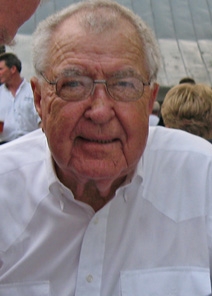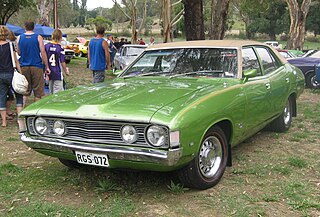See also
- Super GT, a grand touring car race series in Japan
Ford GT is a mid-engine two-seater sports car produced for the 2005 to 2006 model years, and the 2016 to 2020 model years.
It may also refer to:
Unrelated to the cars above:

The Ford GT40 is a high-performance mid-engined racing car originally designed and built for and by the Ford Motor Company to compete in 1960s European endurance racing. Its specific impetus was to best Scuderia Ferrari, which had won the prestigious 24 Hours of Le Mans race for six years running from 1960 to 1965. Around 100 cars have been made, mostly as 289 cu in (4.7 L) V8-powered Mk Is, some sold to private teams or as road legal Mk III cars. Racing started in 1964, with Ford winning World Championships categories from 1966 to 1968. The first Le Mans win came in 1966 with three 427 cu in (7.0 L) powered Mk.II prototypes crossing the finish line together, the second in 1967 by a similarly powered highly modified US-built Mk.IV "J-car" prototype. In order to lower ever-higher race top speeds, a rule change from 1968 onwards limited prototypes to 3.0 litre Formula 1 engines; a loophole, however, allowed the private JW "Gulf Oil" team win at Le Mans in 1968 and 1969 running a Mk.I with a 5.0 litre engines.

A sports car is a type of car that is designed with an emphasis on dynamic performance, such as handling, acceleration, top speed, the thrill of driving, and racing capability. Sports cars originated in Europe in the early 1910s and are currently produced by many manufacturers around the world.

A supercar, also known as an exotic car, is a type of automobile generally described at its most basic as a street-legal sports car with race track-like power, speed, and handling, plus a certain subjective cachet linked to pedigree, exclusivity, or both. The term 'supercar' is frequently used for the extreme fringe of powerful, low-bodied mid-engine luxury sportscars. A low car has both a low, handling-favorable center of gravity, and less frontal area than a front engined car, reducing its aerodynamic drag and enabling a higher top speed. Since the 2000s, the term hypercar has come into use for the highest performance supercars.

Lotus Group is a British multinational automotive manufacturer of luxury sports cars and electric vehicles.

A muscle car is an American-made two-door sports coupe with a powerful engine, generally designed for high-performance driving.

Carroll Hall Shelby was an American automotive designer, racing driver, and entrepreneur.

The Ford Probe is a liftback coupé produced by Ford, introduced in 1988 and produced until 1997. The Probe was the result of Ford's collaboration with its longtime Japanese partner Mazda, and both generations of Probe were derived from the front-wheel drive Mazda G platform that underpinned the Mazda Capella.

The Ford GT is a mid-engine two-seater sports car manufactured and marketed by American automobile manufacturer Ford for the 2005 model year in conjunction with the company's 2003 centenary. The second generation Ford GT became available for the 2017 model year.

Pony car is an American car classification for affordable, compact, highly styled coupés or convertibles with a "sporty" or performance-oriented image. Common characteristics include rear-wheel drive, a long hood, a short decklid, a wide range of options to individualize each car and use of mass-produced parts shared with other models. The popularity of pony cars is largely due to the launch of the Ford Mustang in 1964.
Vignale is the luxury car sub-brand of Ford Motor Company used in automobiles sold in Europe. The former company Carrozzeria Alfredo Vignale was an Italian automobile coachbuilder established in 1948 at Via Cigliano, Turin, by Alfredo Vignale (1913–69). After its founder's death in 1969, Carrozzeria Vignale was acquired by De Tomaso. The studio ceased operation in 1973, but ownership of the name was taken over by Ford Motor Company.

The Shelby Mustang is a high-performance variant of the Ford Mustang built by Shelby American from 1965 to 1967 and by the Ford Motor Company from 1968 to 1970.

Ford Performance Vehicles was the Melbourne-based, premium performance arm of automobile manufacturer Ford Australia. The company produced a range of Ford-based models from 2002 to 2014 under the FPV marque name.

The Mustang SVO is a limited-production version of the third generation Ford Mustang sold from 1984 to 1986, with fewer than 10,000 built. SVO is an acronym referring to Special Vehicle Operations, Ford Motor Company's racing division formed in 1980 to oversee all motorsports operations, distribute performance parts developed in racing programs, and develop high-performance production vehicles derived from motorsports technologies.. Although it departed both physically and mechanically from any prior version of the Mustang, it held the same spot within the lineup, both in terms of performance over "lesser" variants and in prestige, as had variants such as the Shelby-tuned and "BOSS" Mustangs of the 1960s and 1970s.

The Valkyrie is a GT sports car introduced in 1966 by the Fiberfab company. The Valkyrie's styling was inspired by the lines of the Ford GT40.
Ford Mustang variants are the various versions of the Ford Mustang car, modified either by its manufacturer Ford Motor Company or by third-party companies. Ford and several third-party companies have offered many modified versions of the highly popular Mustang since its creation in 1964 in order to cater to specific portions of the marketplace outside of the mainstream. High-performance enthusiasts seek more powerful, sharper handling, sports cars such as the Shelby Mustang, the Ford Mustang Mach 1, and variants made by Roush Performance and Saleen, while collectors and purists seek limited production and alternate or nostalgic styling, such as is commonly found on many commemorative editions. Still, others were made purely for experimental concepts such as the McLaren M81 and the Ford Mustang SVO, which later influenced production model design. Most variants include both performance upgrades, and unique cosmetic treatments that are typically minimal to maintain the familiar appearance of a stock Mustang. Although most of these Mustang variants were aimed at enthusiasts, an exception was the Special Service Package which was designed specifically for law enforcement. Race variants include the FR500, Boss 302 and Boss 429.

The Nissan GT-R is a car built by Japanese marque Nissan since 2007. It has a 2+2 seating layout and is considered both a sports car and a grand tourer. The engine is front-mid mounted and drives all four wheels. It succeeds the Nissan Skyline GT-R, a high-performance variant of the Nissan Skyline. Although this model was the sixth-generation to bear the GT-R name, it is no longer part of the Skyline line-up. The car is built on the PM platform, derived from the FM platform used in the Skyline and Nissan Z models. Production is conducted in a shared production line at Nissan's Tochigi plant in Japan.
Fiberfab was an American automotive manufacturer established in 1964. Starting with accessories and body parts, they progressed to making kit cars and fully assembled automobiles. They became one of the longest lasting kit car manufacturers.

The Ford Falcon (XA) is a full-size car that was produced by Ford Australia from 1972 to 1973. It was the first iteration of the third generation of the Falcon and also included the Ford Fairmont (XA)—the luxury-oriented version. The XA platform was also used for the Australian Ford Landau.

The fifth-generation Ford Mustang, is a two-door four-seater pony car manufactured and marketed by Ford from 2004 to 2014, for the 2005 to 2014 model years — carrying the internal designation S197 and marketed in coupe and convertible body styles. Assembly took place at the Flat Rock Assembly Plant in Flat Rock, Michigan. The fifth generation began with 2005 model year, and received a facelift for the 2010 model year.

The Ford Mustang (S550) is a pony car that is the sixth generation of the Ford Mustang and was produced from 2014 until it was replaced by the seventh generation in 2023.